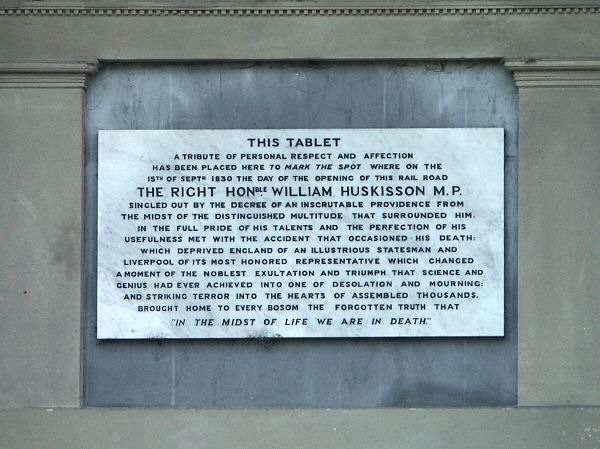

This tablet is a replica. The original was vandalised. Its remains are in the Railway Museum, York.
A TRIBUTE OF PERSONAL RESPECT AND AFFECTION
HAS BEEN PLACED HERE TO MARK THE SPOT WHERE ON THE
15th OF SEPT 1830 THE DAY OF THE OPENING OF THIS RAIL ROAD
THE RIGHT HONBLE WILLIAM HUSKISSON M.P.
SINGLED OUT BY THE DECREE OF AN INSCRUITABLE PROVIDENCE FROM
THE MIDST OF THE DISTINGUISHED MULTITUDE THAT SURROUNDED HIM.
IN THE FULL PRIDE OF HIS TALENTS AND THE PERFECTION OF HIS
USEFULNESS MET WITH THE ACCIDENT THAT OCCASIONED HIS DEATH;
WHICH DEPRIVED ENGLAND OF A ILLUSTRIOUS STATESMAN AND
LIVERPOOL OF ITS MOST HONORED REPRESENTATIVE WHICH CHANGED
A MOMENT OF THE NOBLEST EXULTATION AND TRIUMPH THAT SCIENCE AND
GENIUS HAD EVER ACHIEVED INTO ONE OF DESOLATION AND MOURNING;
AND STRIKING TERROR INTO THE HEARTS OF ASSEMBLED THOUSANDS,
BROUGHT HOME TO EVERY BOSOM THE FORGOTTEN TRUTH THAT
"IN THE MIDST OF LIFE WE ARE IN DEATH."
The opening was an important occasion. So important that the Prime Minister, the Duke of Wellington, took part. At the watering stop, Wellington's train hauled by Northumbrian drew to a halt. Some passengers descended and walked along the track to greet him. Standing beside Wellington's carriage, they formed a group on the track along which other trains were still moving.
Warnings were shouted as a train hauled by Rocket drew close. Some members of the group leapt aside, others clambered quickly into Wellington's carriage, a few squeezed close to his carriage where they should have been safe. Huskisson was one of these. Wellington had just shaken his hand, a sign of reconciliation following recent disagreements between the two politicians. (They were on opposite extremes of the ruling Tory Party, with Wellington being an arch conservative, and Huskisson a reformer.) Maybe Huskisson was preoccupied by this. As the train drew close he held on to the open carriage door. Unfortunately the door was wider than the gap between the two trains. Rocket struck the door, pulling Huskisson off balance and under its wheels. His leg was horribly mangled. He was rushed by train to Eccles, and taken to the parsonage where he died that evening.
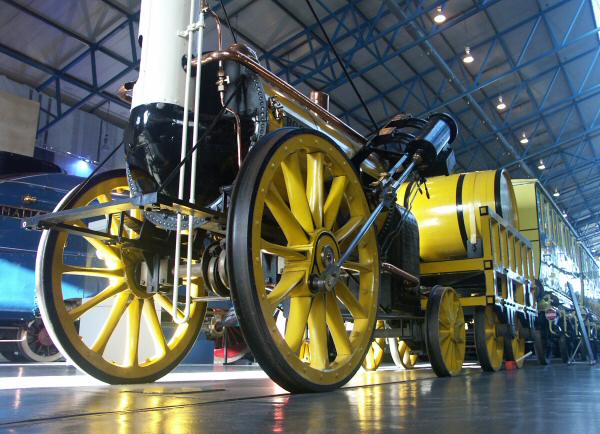
A replica of Rocket, in the Railway Museum, York.
In addition to the Duke of Wellington, those present included:
Prince Esterhazy (the Austrian ambassador),
Count Potocki (the Russian ambassador),
Francis B Ogden (The United States Consul),
the Marquis of Salisbury;
the Earls of: Brecknock, Cassilis, Glengall, Gower,
Lauderdale, Wilton, & Winton;
Viscounts: Belgrave, Grey, Ingestrie, Melbourne, & Sandon;
Lords: Colville, Dacre, Delamere, Gower, Granville,
Grosvenor, Harrowby, Hill, Monson, Stanley,
Skelmersdale, Somerset, Talbot, & Warncliffe;
the Right Hons: C Arbuthnot, J Calcraft, & W Huskisson;
the Hons: G Anson, & H Cholmondely
Sir T Freemantle, Sir J Graham MP, Sir Robert Peel, Sir S Scott,
Sir J Wyatville, & Sir J Wrottesley MP;
General Gascoyne MP,
Admiral White,
Colonel Cust MP;
Charles Babbage,
George Stevenson,
Robert Stevenson,
Charles Vignoles;
Wm W Whitmore Esq MP,
W Patten Esq MP,
H Grenville Esq,
E J Littleton MP,
W Holmes Esq MP,
Sir George Drinkwater (Mayor of Liverpool),
Alderman Thompson MP,
the Boroughreeves of Manchester and Salford.
Dr Southey (a physician to George IV),
Dr Hunter (Professor of Anatomy at Edinburgh),
Dr Joseph Brandreth.
Reverend Thomas Blackburne (vicar of Eccles).
A number of "ladies of rank" were present, but the newspaper doesn't name them. Many were wives of the men already mentioned. A few there in their own right, including the actress Fanny Kemble and her mother.
The eight trains, carrying over 800 people, set off from Liverpool in great style. The Liverpool Courier described the trains as "splendid vehicles" which "unmoored" (from the railway station) and "rolled slowly and majestically into the mouth of the arch", (of a tunnel leading out of the station). "Our speed gradually increased till, entering Olive Mount excavation, we rushed into the awful chasm at the rate of twenty-four miles an hour. The banks, and bridges over our heads, and the rude projecting corners along the sides, were covered with masses of human beings, past which we glided as if upon the wings of the wind. We soon came into the open country of Broad Green, having fine views of Huyton and Prescot on the left, and the hilly ground of Cheshire on the right."
All along the route people by the thousand were waiting for the spectacle to roll by. At the watering stop, grandstands had been erected to give the crowds a better view.
Then the accident. It could not have had a higher profile: on the opening day of THE railway, directly in front of the Prime Minister and a host of other important people, witnessed by a large crowd assembled for the occasion. The offending machine was the much acclaimed winner of the Rainhill locomotive trials. The victim, a leading supporter of the railway: the Member of Parliament who had worked so hard to obtain Parliamentary approval for the line.
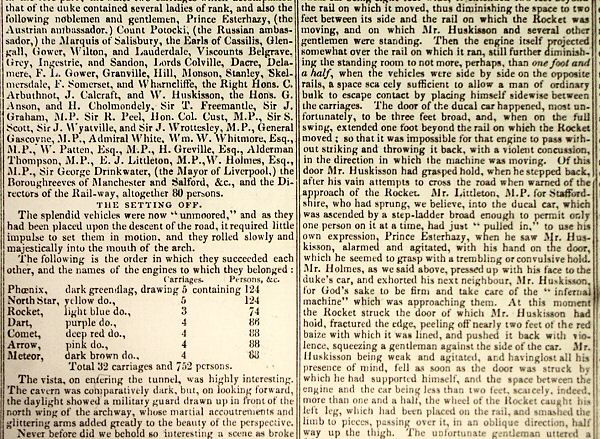
Once the casualty had been cared for, there was a discussion. Some wanted to abandon the opening ceremony and return immediately to Liverpool, but massive crowds were waiting in Manchester, there were fears for what may happen if the trains failed to appear. Eventually it was decided to continue.
With the delay, and the loss of an engine to carry Huskisson, the plans started to fall apart. A very ragged group of trains eventually reached Manchester. After ceremonies they returned to Liverpool far too late for the banquet. The engines had to grope their way back at a very slow pace because they were completely unprepared for travel in the dark. Many passengers abandoned the train and returned by horse.
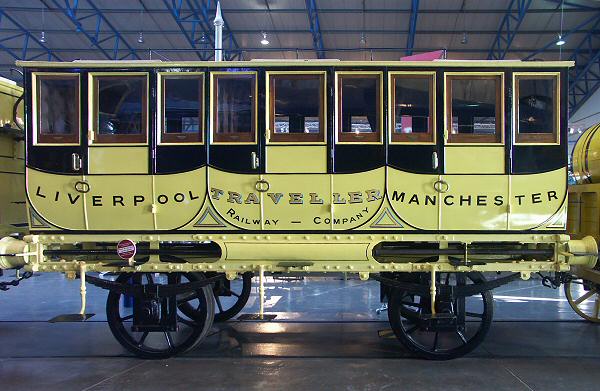
A replica of an original first class carriage, in the Railway Museum, York.
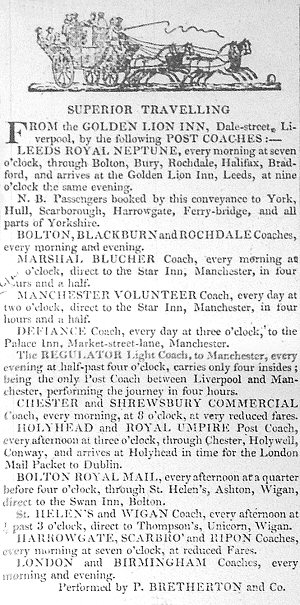 The opening day ended in tragedy and chaos, but the Liverpool and Manchester Railway (L&M) proved to be a spectacular success.
It revolutionised public transport and created a new travel market.
The formula it pioneered was copied by other railways.
So what made the L&M so revolutionary?
The opening day ended in tragedy and chaos, but the Liverpool and Manchester Railway (L&M) proved to be a spectacular success.
It revolutionised public transport and created a new travel market.
The formula it pioneered was copied by other railways.
So what made the L&M so revolutionary?
Before the L&M, most trains had been drawn by horse walking at about 4 miles per hour (rails and galloping teams don't mix). It is not surpising that, although they carried freight, trains failed to take passengers from stage-coaches (which averaged 6 mph), or post-coaches (9 mph). Many railways were private, carrying goods for specific quarries, mines, and factories. Those open to the public (such as the Stockton and Darlington which opened in 1825) operated as a turnpikes. Anyone who paid the tolls and obeyed the rules could run his horse and waggon on the line. A few steam loco-motives had been used, and had improved over the years since Trevithick's original of 1804, but they had to plod along at the same speed as the horses (you can't overtake on a railway track).
There was great potential for a railway spanning the 36 miles between Manchester, centre of the world cotton industry,
and Liverpool, the port for communication with suppliers and customers.
When planning the railway, the directors decided to go for a speed that would attract passengers as well as goods,
and made two bold and innovative decisions:
- to use only steam power,
- to operate the trains themselves.
Locomotives on the L&M were unhindered by horses, they were freed to show their full potential. The track was built specially for them. It supported heavy locomotives that could grip the track well and were powerful. By operating both track and trains the company gave a complete transport service and could tune its performance. The result was speed and efficiency unseen before.
A year before the opening, on a section of completed track at Rainhill, the company had organised trials to see what the latest locomotives could do. The trials were won by Rocket designed by Robert Stephenson. To our eyes it may look old-fashioned, but it was simple and efficient compared with earlier locomotives. Its basic design, a multi-tubed boiler and pistons driving wheels via a simple linkage, became the model for the future.
The directors initially aimed for a speed of 10 mph (which would have beaten the coaches), but upped their aim after seeing how well locomotives performed in the trials. On the opening journey, the trains achieved 24 mph, and locomotives continued to improve. The journey between the two towns (6 hours by stage-coach) was immediately reduced to two hours, and within a few years was taking less than an hour.
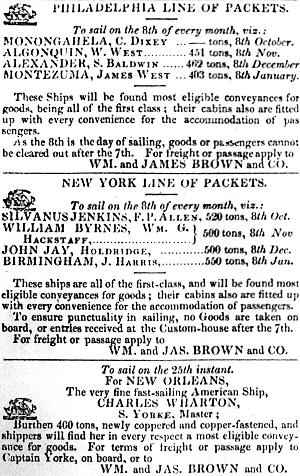 Speed was not the only improvement.
A train carried ten times as many passagers as a coach, and did five journeys in the time a coach did one,
an improvement in vehicle efficiency of five-thousand percent.
Put another way, one train did the work of fifty stagecoaches and four-hundred horses.
The cheapest stage-coach seat between the two towns had been 16 shillings return,
the best part of a week's wages for a skilled man.
By 1831 the equivalent rail journey was 7 shillings,
and the cost of travel continued to fall.
Speed was not the only improvement.
A train carried ten times as many passagers as a coach, and did five journeys in the time a coach did one,
an improvement in vehicle efficiency of five-thousand percent.
Put another way, one train did the work of fifty stagecoaches and four-hundred horses.
The cheapest stage-coach seat between the two towns had been 16 shillings return,
the best part of a week's wages for a skilled man.
By 1831 the equivalent rail journey was 7 shillings,
and the cost of travel continued to fall.
L&M steam trains swept straight across country on sturdy L&M track, kept level using cuttings and embankments, and crossing main roads via bridges rather than level crossings. Their speed, and the comfort of the first class accommodation, took the passengers and mail from coaches. The less expensive second and third class accommodation created a new market for those who previously could not afford to travel.
This form of railway was so successful, it was soon extended, reaching Birmingham by 1837, and London the following year. Existing railways converted to the L&M formula. New railways were built all over the country and the world.
For the first time almost anyone could afford to travel. Before long, people began to build homes in the country and commute into town. The L&M issued its first season ticket in 1842. Railway stations such as Cheadle Hulme, Alderley Edge, and Holmes Chapel were built in the countryside, giving names to new villages that grew around them.
The L&M was soon operating excursion trains, including to Newton Races, a racecourse near the track. People began to travel for pleasure, making day trips, and summer holidays by the seaside. New towns were built at the seaside to provide facilities for trippers: Southport, Blackpool, and Llandudno were born.
New towns also arose at major rail junctions to house railway workers, Crewe is an example. New industries were created to bring milk and other fresh produce into town. Towns served by the railway expanded. The rural economy benefited. The form of railway pioneered by the L&M changed peoples lives.
Humans have a perilous relationship with speed. Each increase involves a step into the unknown. The L&M engineers had a lot to learn about safety. The accident showed that brakes (Rocket had none, but could be slowed by being "thrown into reverse"), audible warning devices, and passenger shepherding all needed attention, as did the gap between trains on adjacent tracks (the tracks were soon moved further apart). Huskisson's was not the only accident on the opening day. When one train stopped suddenly, another ran into it giving a nasty jolt to passengers on both trains, luckily without serious injury or damage. To give the L&M engineers their due, they were ready to learn and quick to take corrective action.
The engineers underestimated the capabilities of steam locomotives. They thought that locomotives needed as much assistance as possible. Pre-heating their water supply was just one of the measures taken. The old water tower to which the Huskisson memorial is fixed contained hot water for the locomotives, with a furnace nearby to heat it.
They thought that a loco-motive would not be able to haul a train uphill. When designing the line they planned to use loco-motives only on the level. They installed stationary engines to wind carriages up and down hill using ropes, as is still done on steeper hills in Llandudno and San Francisco.
The winner of the Rainhill locomotive trials proved capable of hauling its train uphill. The stationary engines weren't needed on most of the inclines, (they were used for a short time on an incline at the Liverpool end of the track), but they already had a major impact on track layout. For stationary engines, inclines need to be short, but can be steep. The track was therefore built with long fairly level sections and a few short sharp inclines, a layout familiar to canal engineers. On later railways, to help the locomotives, inclines were kept as gentle as possible by spreading them over longer distances.
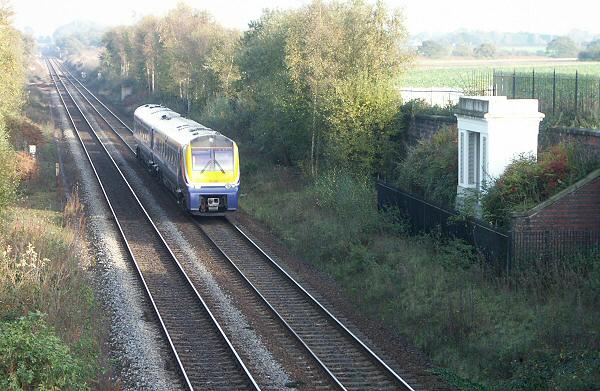
Lyonel next heard of his mother 19 years later. He received a letter from her a few days after he married. It said she was sorry she had not been at the wedding, but would dearly love a photograph. Lyonel was unimpressed. After all, she had abandoned him when he needed her? He tore the letter into tiny pieces and threw them in the dustbin.
His father heard about the letter, obtained the contents of the bin, and pieced the bits together. She had given a Liverpool address and he lived near Manchester. The following Saturday he set off on the old L&M line. 103 years after that opening day, the railway was still the main means of travel between the two cities.
He took two things: the requested photograph, and a bunch of flowers. Two months later they re-married. Thus my grandparents became the loving couple I knew as a child.